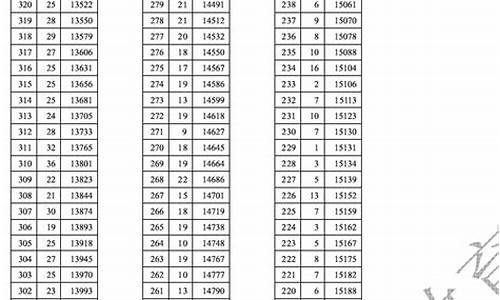您现在的位置是: 首页 > 教育改革 教育改革
2024高考英语非谓语在写作中的运用公开课原创力课件,2024高考英语非谓语
tamoadmin 2024-06-11 人已围观
简介1.高考英语语法主要考哪些2.高考英语语法辅导:非谓语动词做定语3.高考英语,非谓语的一道问题4.高考英语必背知识点有哪些?5.高考英语语法考点总结被动语态是英语语法中的一个重要概念,也是许多学习者的难点。我们将深入探索谓语与非谓语的被动语态,让你们在掌握知识的同时,享受语言的美妙。谓语的被动语态谓语的被动语态有多种时态变化,包括现在进行时的被动语态、过去完成时的被动语态、含情态动词的被动语态等。
1.高考英语语法主要考哪些
2.高考英语语法辅导:非谓语动词做定语
3.高考英语,非谓语的一道问题
4.高考英语必背知识点有哪些?
5.高考英语语法考点总结

被动语态是英语语法中的一个重要概念,也是许多学习者的难点。我们将深入探索谓语与非谓语的被动语态,让你们在掌握知识的同时,享受语言的美妙。
谓语的被动语态
谓语的被动语态有多种时态变化,包括现在进行时的被动语态、过去完成时的被动语态、含情态动词的被动语态等。这些时态变化的规律,让我们更好地理解被动语态的应用。
非谓语的被动语态非谓语的被动语态同样精彩纷呈,包括不定式的被动语态和doing的被动语态。这些语态的应用,让我们更好地理解被动语态的语法结构。
学习笔记分享本文分享了被动语态的谓语和非谓语的应用,希望能够帮助大家更好地掌握这一语法知识。如果你觉得这些内容对你有所帮助,别忘了分享给你的朋友们哦!
高考英语语法主要考哪些
高二英语 在整个高中英语中占有非常重要的地位,既是高二又是整个高中阶段的重难点,所以要保持良好的学习心态和正确的 学习 方法 。接下来是我为大家整理的英语高考必背知识要点,希望大家喜欢!
英语高考必背知识要点一
一、不定式做主语:
1、不定式做主语一般表示具体的某次动作。===动名词doing 表示习惯的,经常的动作。
e.g: To finish the building in a month is difficult.
To do such things is foolish.
To see is to believe. (对等)
注: 1). 不定式作主语时,谓语用单数
2). 当主语较长,谓语较短时,常用it做形式主语,而将不定式放到谓语的后面。
it做形式主语,不定式放在谓语动词之后常用于下列结构中:
(1)It is/was +adj.+of sb. to do…
(2) It is +adj.+for sb.+to do…
It is easy / difficult / hard / foolish / unwise / right / wrong / unnecessary
(3) it is +a +名词+ to do...
It is a pity / a pleasure / a pleasant thing / one’s duty / an honor / a shame / a crime / no easy job… to do
It takes (sb.) some time / courage / patience …to do…
It requires courage / patience / hard work… to do…
注意: probable 和 possible 均可作表语,但possible可以用不定式作真实主语, 而probable不能用不定式作真实主语。
It is probable for him to come to the meeting.(错)
It is possible for him to come to the meeting.
It is possible / probable that he will come to the meeting.
英语高考必背知识要点二
一、非谓语动词
“非谓语动词”可分为动词不定式、动名词和分词.它在 句子 中的作用很多:除了不作谓语外,它可以充当主语、宾语、表语、定语、状语与复合宾语(主语补语或宾语补语).有些及物动词后面接不带to的不定式作复合宾语.这些动词归纳如下:一感(feel).二听(hear,listen to),三让(have,1et, make),四看(see,watCh,notice,observe).再加上help somebody(to)do something和美国英语look at somebody do somthing.还有“二让”属特殊:get somebody to do something 与keep somebody doing.而有些及物动词后面接动名词(the -ing form)作宾语.这些动词归纳为一句话:Papa C makes friends.这是由如下动词的开头字母组成:permit,advise, practise,avoid,consider,mind, allow,keep,enjoy,suggest, finish,risk,imagine,escape,need,delay,stand(忍受). 为了容易记住,也可以编成 顺口溜 :“允许完成练习,建议避免冒险,考虑延期逃跑,喜欢保持想象,需要反对忍受”.其相对应的动词依次是:permit/allow,finish,practise;
advise/suggest, avoid,risk: consider, delay, escape/miss; enjoy/appreciate, keep, imagine; need/want/require,mind. can't help/can’t stand.
二、复合句
1、学生最容易混淆的是定语从句与同位语从句的区别.
例如:A、The news that our team has won the match is true. (同位语从句)
B、The news that he told us surprised everybody here. (定语从句)
关键的区别在于连接或关系代词that:有意义的是定语, 无意义的是同位.因为引导定语从句的that在从句中作主语或 宾语,而引导同位语从句的that只起到连接词的作用.
2、接着容易混淆的是引导定语从句的关系代词that与 which:that之前是不定(代词)、序数(词)、(形容词)级:which之前是介词 短语 与逗号(非限制性).
例如:A、All that we have to do is to practise every day.
B、The first lesson that I learned will never be forgotten.
C、I have lost my pen,which I like very much.
D、The house in front of which there is a garden is my home.
三、It的用法
1、It除了代替人和物以外,还可以作形式主语.而真正的主语(不定式、动名词或从句)则放于谓语或表语之后.
例如:It is nor easy to finish the work in two days.
然而有少数表语之后接动名词作真正的主语.这些表语是:无助(no help)、无用(no use)、没好处(no good);工作(hard work)、费时(a waste of time)、又危险(a danger).
例如:A、It is no use crying over spilt milk.
B、It is a waste of time waiting for him.
2、It还可以作形式宾语.通常下列动词后面可接it作形式宾语:2f2tcjm(find,feel,think,take,consider,judge, make).
例如:A、He made it clear that he was not interested in this subject.
B、I think it no use arguing with him.
3、It用于强调句式.要强调句子的某一部分(主语、宾语、 状语),可以把it当作先行词.这种句子的结构是:It is(was)+ 被强调部分+that(who)+句子的其余部分.
例如:A、It iS Professor Lin who teaches us English—(强调主语)
B、It was in Shanghai that l saw the film.—(强调状语)
C、It was in 1990 that I worked in the factory.(同上)
但要注意与定语从句的区别.
例如:D、It was 1990 when I worked in the factory.(定语从句)
在强调句式里,我们把强调结构It is(was)…that除去,句子还很完整.如例句C.而例句D就不能.
四、倒装结构
学生容易混淆的是全部倒装与部分倒装.如何区分之,编个顺口溜:副(adv.)介(prep.)提前全倒装, 其它 句式部分倒;否定提前倒助动,让步状语倒表语;复合句式倒主句,不
倒装的属特殊.下面举例说明:
A、Here comes the bus.(副词提前,全倒装)
B、Here he comes.(代词作主语,不倒装)
C、In front of the house lies a garden.(介词短语提前,全倒装)
D、Never shall I do this again.(否定词提前,部分倒装)
E、Young as he is ,he knows a lot.(让步状语从句,表语倒装)
F、Only when he told me did I realize what trouble he was in.(only 修饰状语,主句倒装)
G、Only he can save the patient.(only修饰主语.不倒装)
H、Not only will help be given to people,but also medical treatment will be provided.(否定词提前,部分倒装)
I、Not only he but also we like sports.(连接两个主语,不倒装)
五、虚拟语气
虚拟语气也是一个难点.所谓虚拟语气是表示说话人的愿望、假设、猜测或建议,而不表示客观存在的事实.它通过句子的谓语动词的特殊形式来表示.现归纳如下:纯假设,用虚拟,动词时态退一级:条件句,分主从,主句谓语前加would (should,could,might);表愿望,用虚拟,wish后面接宾语(从句):现在过去与将来,动词时态退一级:提建议,用虚拟,宾语(从句)动词用(should)do:俩建议,三要求,再加坚持与命令(suggest,advise,demand,require,request,insist,order):It is time和eoukd rather,后接丛句用虚拟:部分主语从句中, 谓语用虚拟结构 (It is necessry /important/natural/natural/strange/strange that……should do). 下面举例说明:
A、If you came tomorrow,we would have the metting. (条件句虚拟)
B、Without air,there would be no living things.(同上)
C、We wish we had arrived there two hours earlier.(表示愿望虚拟)
D、He demanded that we (should)start right away.(表示建议虚拟)
E、It is(high)time that we left (should leave)now.(特殊从句虚拟)
F、I would rather you gave me the book.(同上)
G、It is necessary that we should clean the room everyday,(主语从句虚拟)
H、He speaks English so fluently as if he were English. (特殊从句虚拟)
英语高考必背知识要点三
1. 高考 英语口语 考试必背
2. I see. 我明白了。
3. I quit! 我不干了!
4. Let go! 放手!
5. Me too. 我也是。
6. My god! 天哪!
7. No way! 不行!
8. Come on. 来吧(赶快)
9. Hold on. 等一等。
10. I agree。 我同意。
11. Not bad. 还不错。
12. Not yet. 还没。
13. See you. 再见。
14. Shut up! 闭嘴!
15. So long. 再见。
16. Why not? 好呀! (为什么不呢?)
17. Allow me. 让我来。
18. Be quiet! 安静点!
19. Cheer up! 振作起来!
20. Good job! 做得好!
21. Have fun! 玩得开心!
22. How much? 多少钱?
23. I'm full. 我饱了。
24. I'm home. 我回来了。
25. I'm lost. 我迷路了。
26. My treat. 我请客。
27. So do I. 我也一样。
28. This way。 这边请。
29. After you. 您先。
30. Bless you! 祝福你!
31. Follow me. 跟我来。
32. Forget it! 休想! (算了!)
33. Good luck! 祝好运!
34. I decline! 我拒绝!
35. I promise. 我保证。
36. Of course! 当然了!
37. Slow down! 慢点!
38. Take care! 保重!
39. They hurt. (伤口)疼。
40. Try again. 再试试。
41. Watch out! 当心。
42. What's up? 有什么事吗?
43. Be careful! 注意!
44. Bottoms up! 干杯(见底)!
45. Don't move! 不许动!
46. Guess what? 猜猜看?
47. I doubt it 我怀疑。
48. I think so.我也这么想。
49. I'm single. 我是单身贵族。
50. Keep it up! 坚持下去!
英语高考必背知识要点有哪些相关 文章 :
1. 高考英语必背知识点
2. 2017年高考英语必背知识点
3. 高考英语必考的40个重点句型
4. 2020新高三英语超全规划与高考英语高分必背知识点
5. 高二英语必背知识点重点归纳
6. 英语高考知识点归纳
7. 英语高考知识点总结归纳
8. 高考英语知识点归纳整理
9. 高考英语知识点归纳
10. 高考英语知识点考点归纳
高考英语语法辅导:非谓语动词做定语
一、非谓语动词
“非谓语动词”可分为动词不定式、动名词和分词。它在句子中的作用很多:除了不作谓语外,它可以充当主语、宾语、表语、定语、状语与复合宾语(主语补语或宾语补语)。有些及物动词后面接不带to的不定式作复合宾语。这些动词归纳如下:一感(feel).二听(hear,listen to),三让(have,1et, make),四看(see,watCh,notice,observe)。再加上help somebody(to)do something和美国英语look at somebody do somthing。还有“二让”属特殊:get somebody to do something 与keep somebody doing。而有些及物动词后面接动名词(the -ing form)作宾语。这些动词归纳为一句话:Papa C makes friends。这是由如下动词的开头字母组成:permit,advise, practise,avoid,consider,mind, allow,keep,enjoy,suggest, finish,risk,imagine,escape,need,delay,stand(忍受)。 为了容易记住,也可以编成顺口溜:“允许完成练习,建议避免冒险,考虑延期逃跑,喜欢保持想象,需要反对忍受”。其相对应的动词依次是:permit/allow,finish,practise;
advise/suggest, avoid,risk: consider, delay, escape/miss; enjoy/appreciate, keep, imagine; need/want/require,mind. can't help/can’t stand。
二、复合句
1、学生最容易混淆的是定语从句与同位语从句的区别。
例如:A、The news that our team has won the match is true. (同位语从句)
B、The news that he told us surprised everybody here. (定语从句)
关键的区别在于连接或关系代词that:有意义的是定语, 无意义的是同位。因为引导定语从句的that在从句中作主语或 宾语,而引导同位语从句的that只起到连接词的作用。
2、接着容易混淆的是引导定语从句的关系代词that与 which:that之前是不定(代词)、序数(词)、(形容词)最高级:which之前是介词短语与逗号(非限制性)。
例如:A、All that we have to do is to practise every day.
B、The first lesson that I learned will never be forgotten.
C、I have lost my pen,which I like very much.
D、The house in front of which there is a garden is my home.
三、It的用法
1、It除了代替人和物以外,还可以作形式主语。而真正的主语(不定式、动名词或从句)则放于谓语或表语之后。
例如:It is nor easy to finish the work in two days.
然而有少数表语之后接动名词作真正的主语。这些表语是:无助(no help)、无用(no use)、没好处(no good);工作(hard work)、费时(a waste of time)、又危险(a danger)。
例如:A、It is no use crying over spilt milk.
B、It is a waste of time waiting for him.
2、It还可以作形式宾语。通常下列动词后面可接it作形式宾语:2f2tcjm(find,feel,think,take,consider,judge, make)。
例如:A、He made it clear that he was not interested in this subject.
B、I think it no use arguing with him.
3、It用于强调句式。要强调句子的某一部分(主语、宾语、 状语),可以把it当作先行词。这种句子的结构是:It is(was)+ 被强调部分+that(who)+句子的其余部分。
例如:A、It iS Professor Lin who teaches us English—(强调主语)
B、It was in Shanghai that l saw the film.—(强调状语)
C、It was in 1990 that I worked in the factory.(同上)
但要注意与定语从句的区别。
例如:D、It was 1990 when I worked in the factory.(定语从句)
在强调句式里,我们把强调结构It is(was)…that除去,句子还很完整。如例句C。而例句D就不能。
四、倒装结构
学生容易混淆的是全部倒装与部分倒装。如何区分之,编个顺口溜:副(adv.)介(prep.)提前全倒装,其它句式部分倒;否定提前倒助动,让步状语倒表语;复合句式倒主句,不
倒装的属特殊。下面举例说明:
A、Here comes the bus.(副词提前,全倒装)
B、Here he comes.(代词作主语,不倒装)
C、In front of the house lies a garden.(介词短语提前,全倒装)
D、Never shall I do this again.(否定词提前,部分倒装)
E、Young as he is ,he knows a lot.(让步状语从句,表语倒装)
F、Only when he told me did I realize what trouble he was in.(only 修饰状语,主句倒装)
G、Only he can save the patient.(only修饰主语.不倒装)
H、Not only will help be given to people,but also medical treatment will be provided.(否定词提前,部分倒装)
I、Not only he but also we like sports.(连接两个主语,不倒装)
五、虚拟语气
虚拟语气也是一个难点。所谓虚拟语气是表示说话人的愿望、假设、猜测或建议,而不表示客观存在的事实。它通过句子的谓语动词的特殊形式来表示。现归纳如下:纯假设,用虚拟,动词时态退一级:条件句,分主从,主句谓语前加would (should,could,might);表愿望,用虚拟,wish后面接宾语(从句):现在过去与将来,动词时态退一级:提建议,用虚拟,宾语(从句)动词用(should)do:俩建议,三要求,再加坚持与命令(suggest,advise,demand,require,request,insist,order):It is time和eoukd rather,后接丛句用虚拟:部分主语从句中, 谓语用虚拟结构 (It is necessry /important/natural/natural/strange/strange that……should do)。 下面举例说明:
A、If you came tomorrow,we would have the metting. (条件句虚拟)
B、Without air,there would be no living things.(同上)
C、We wish we had arrived there two hours earlier.(表示愿望虚拟)
D、He demanded that we (should)start right away.(表示建议虚拟)
E、It is(high)time that we left (should leave)now.(特殊从句虚拟)
F、I would rather you gave me the book.(同上)
G、It is necessary that we should clean the room everyday,(主语从句虚拟)
H、He speaks English so fluently as if he were English. (特殊从句虚拟)
总之,语法是从语言实践中总结出来的规则,要边学边寻找规律,以提高学习效率。在学习中不能只记一些语法规则,要进行实践练习。通过练习,可以发现和纠正错误,而且有利于况固所学知识。
高考英语,非谓语的一道问题
南开中学 李士明
非谓语动词做定语
直接修饰名词的成分称为定语,一般由形容词或名词担当,也可以分别由不定式、分词或动名词等非谓语动词来担当。那么如何区别并正确使用非谓语动词呢?
NON-FINITES
1. 现在分词与过去分词的区别
我们知道非谓语动词都源于及物和不及物两种谓语动词,要了解现在分词与过去分词的区别就要从谓语动词的基本属性开始。
1)及物动词 (v.t.)
及物动词的主语我们称为动作的发出者(sender),宾语称为动作的承受者(receiver)。
例如:
The news surprised
动词+ing (发出者) 及物动词v.t.
the students.
动词+ed (承受者)
Surprise是及物动词, 在使用surprise这个动词的非谓语分词形式时,修饰动作发出者news用现在分词形式(动词+ing),修饰动作的承受者用过去分词形式(动词+ed)。
●They are talking about the surprising news. (surprising做定语修饰发出者news)
The news is surprising. (surprising做表语修饰发出者news)
They are talking about the surprised students. (surprised做定语修饰承受者students)
The students are surprised. (surprised做表语修饰承受者students)
再来看几个例子:
●exciting games激烈精彩的比赛, excited spectators激情振奋的观众
●disappointing results令人沮丧的结果, disappointed people大失所望的人们
●exhausting work令人疲惫不堪的工作, exhausted workers筋疲力尽的工人
●moving stories感人肺腑的故事, moved students感激涕零的学生
从以上例子可见,现在分词和过去分词都可以用作形容词来修饰名词,修饰动作发出者用现在分词,修饰动作承受者用过去分词。要特别注意的是,依据被修饰的名词是人还是物来判断现在分词和过去分词的用法是不准确的。
例如: They complicated the situation by introducing some more restriction.
他们采用了一些更多的限制把形势复杂化了。
及物动词complicate的发出者是人they, 而承受者是物。因此,“复杂恶化的形势”应译为the complicated situation,“形势是令人棘手的” 应译为The situation is complicated.
从这个例子可以清楚地看出,如果根据中文,很容易将“令人棘手的形势”错误地理解为 “complicating situation”。
再比如我们常用的:
a broken cup 一个破杯子; spoken English英语口语;exported products出口产品。
因此,准确了解所修饰的名词与及物动词的关系,是正确使用及物动词的现在分词和过去分词的关键。
2) 不及物动词(v.i.)
不及物动词只有动作的发出者,不存在动作的承受者。因此,不及物动词的现在分词源于进行时,表示动作正在进行,而过去分词则源于完成时,表示动作已完成。
例如:
●He looked at the leaves which are falling in the air.(从句用进行时修饰名词the leaves)
他看着空气中飘然下落的叶子。
=He looked at the leaves falling in the air.(现在分词短语修饰名词the leaves表示进行)
=He looked at the falling leaves in the air. (现在分词修饰名词the leaves表示进行)
●He walked on the leaves which had fallen on the ground.(从句用完成时修饰名词the leaves) 他走在地面的落叶上。
He walked on the leaves fallen on the ground.(过去分词短语修饰名词leaves表示过去)
He walked on the fallen leaves on the ground. (过去分词修饰名词leaves表示过去)
●the rising sun. = the sun that is rising. 冉冉升起的太阳
the risen sun = the sun that has risen. 已经升在天空的太阳
●boiling water = water which is boiling. 沸腾的水
boiled water = water which has boiled 开过的水
2. 不同形式不定式做定语的区别
动词不定式的一般式可以用做形容词,担当名词的定语, 表示将要发生的动作,不定式的进行式和完成式都不可以用作定语。
1)及物动词不定式一般式主动to do sth和被动to be done 两种形式的区别。
例如:
●Have you anything to send? = Have you anything that you will send?
你有什么东西要(自己)寄吗?(主动含义,动作由you自己去完成)
(to send做定语, 源于定语从句that you will send, 修饰先行词anything, 表示将来。)
●Have you anything to be sent (by others)?=Have you anything that will be sent(by others)?
你有什么东西要(我或别人)寄吗?(被动含义,动作由他人others去完成)
(to be sent做定语, 源于定语从句that will be sent, 修饰先行词anything, 表示将来。)
从以上两个例子可以看出,不定式的主动形式to send来源于主动语态的定语从句。
而不定式的被动形式to be sent来源于被动语态的定语从句, 不能错误地认为to send 是主动形式表示被动,准确地讲应该牢记主动形式的不定式源于主动语态的从句,被动形式的不定式则源于被动语态的从句,两者绝不可以混淆。
●I have some books for you to read. = I have some books that you should read.
我有几本书希望你读一读。
(for you to read做定语, 源于定语从句that you should read, 修饰先行词books, 表示将来。原从句的主语you在不定式的前面以for you 的形式出现,担当不定式的逻辑主语。)
2)不及物动词不定式一般式做定语
当不及物动词做定语时, 后面必须有相应的介词与前面所修饰的名词相呼应, 从汉语角度理解,而忽略了必要的介词是不及物动词做定语时常见的错误。
例如:
●He is looking for a room to live in.= He is looking for a room which he will live in.
他现在正在找房间住。
(to live in做定语, 源于定语从句which he will live in, 修饰先行词room, 表示将来。)
●Would you like to have another pen to write with? ( to write with the pen)
你需要再准备一支笔用吗?
●Smith is a good man to work with. ( to work with the man)
与史密斯一起工作是再好不过了。
●Lei Feng is a brilliant example for us to learn from. ( to learn from the example)
雷锋是我们学习的光辉榜样。
●Can you lend me a chair to sit on?
您可以借给我一把椅子坐吗?
●Global Financial Crisis is a hot topic to talk about today. ( to talk about the topic)
全球性金融危机是当前人们谈论的热点话题。
高考英语必背知识点有哪些?
选B显然是对的。考查的是非谓语动词的一种用法:动词不定式做定语。首先你有两个概念上的模糊。这里的B选项,to carry out the mission本来就是做定语的,用来修饰He。而不是A选项作定语,其次,并不是所有的不定式都是用来表目的的,不定式的用法有很多,你可以在网上查,表目的的时候是状语而不是定语,你要明白定语是用来修饰名词的,状语是用来修饰动词或形容词的。
我们来分析一下这个句子:
主语(He)+系动词(was)+表语( one of only a few people )+定语1( with both practical skills and scientific knowledge )+定语2(to carry out the mission)
我们说定语是用来修饰名词的,定语1就是用来修饰a few people的,由于此句主语也是名词,那么定语2是用来修饰主语的,这里的定语2与主语是一个主谓的关系,即:He carries out the mission。他执行这个任务。
这句就可以简化为:
He was one (people) to carry out the mission.他是一个执行这个任务的人。
He was one of only a few people with both practical skills and scientific knowledge to carry out the mission.他是(少数的同时具备实践技能和理论知识的人中的其中一个)可以执行这个任务的人。
高考英语语法考点总结
一、谓语动词和非谓语动词
从是否能充当句子中的谓语来看,动词有谓语动词和非谓语动词两大类。
1、谓语动词
有人称和数的变化。如:He?is?a tractor driver.他是一个拖拉机手。
2、非谓语动词?
非谓语动词有动词不定式、动名词和分词三种,在句子里都不能单独作谓语,没有人称和数的变化。如:I am pleased?to meet you.我很高兴与你相识。(动词不定式)
二、实义动词、连系动词、情态动词和助动词
从其含义来分,动词有实义动词(notional verb),连系动词(link verb),情态动词(modal verb)和助动词(auxiliary verb)四类。
1、实义动词?
实义动词有完全的词义,并能独立作谓语动词。
如:The sun?shone?brightly this morning.
今天早晨阳光灿烂。
2、连系动词?
连系动词在句中作谓语动词,后面跟表语。英语连系动词有be(是),seem(似乎),look(看来),keep(保持),become(变成),get(变得),grow(变得),feel(感到),turn(变得,变成),appear(显得),remain(仍旧是)等。
如:It?is?never too late to mend.
改过不嫌晚。
3、情态动词?
情态动词有can (能),may (可以,也许),must(必须)等,表示能力、义务、必要、猜测等说话人的语气或情态。情态动词只能和主要动词一起构成谓语动词。
4、助动词?
助动词有shall,will,have,be,should,wonld, do等。它们只能和主要动词一起构成各种时态、语态、语气等动词形式,以及否定和疑问等结构中的谓语动词。
三、及物动词和不及物动词
从是否能直接跟宾语来分,实义动词又有及物动词和不及物动词两类。
1、及物动词?
后面必须跟宾语意义才完整的实义动词,叫做及物动词(transitive verb)。
如:I?believe?that the committee will?consider?our suggestion.
我相信委员会将会考虑我们的建议。
2、不及物动词?
本身意义完整后面不须跟宾语的实义动词,叫做不及物动词(intransitive verb)。
如:It?happened?in June 1932.
这件事发生于一九三;年六月。
3、兼作及物动词和不及物动词?
英语里有不少实义动词可以兼作及物动词和不及物动词。这样的动词又有两种不同的情况:
a) 兼作及物动词和不及物动词时,意义不变。试比较:
Shall I begin at once?我可以立刻开始吗?(begin作不及物动词)
She began working as a librarian after she left school.她毕业后当图书馆管理员。(began作及物动词)
b) 兼作及物动词和不及物动词时,有时意义不尽相同。
如:Wash your hands before meals.饭前要洗手。
四、情态动词
在行为动词、连系动词以外,还有两类动词,其中之一就是情态动词。从字面上看,我们就知道这是表示“感情与态度”的动词。
比如:I?can?do it without much difficulty. (能够,表示自信)
事实上,情态动词的英文说法modal verb,还是值得推敲的。modal,来自于名词mode,和modality(模式,方式)紧密相关,包括likelihood可能性, ability 能力, permission 许可与obligation责任这四种模式。
情态动词自身所具备的意义一般来说也是不完整的,不过和需要涉及其他事物的及物动词不同,情态动词不涉及其他事物,需要的是其他动词,即行为动词和连系动词,来配合使用。
一般来说情态动词是不能用作行为动词的,但也有例外,比如need,既可以用作情态动词,也可以是行为动词,看它的后面跟的是什么。
五、助动词
还有一类动词,也是意义上不完整、需要配合行为动词、连系动词使用的,那就是助动词。顾名思义,助动词就是用来帮助主要动词构成谓语的。
主要包括进行时态的be(is / am / are / was / were)、一般时态的do / does / did,将来时态的will / shall / would / should和完成时态的have / has / had。这种动词的英文名称叫auxiliary verb,简写是v. aux.。
一.非谓语动词
一.不定式:
一)不定式的常考形式:
1) 一般形式:He decided to work harder in order to catch up with the others.
被动形式: He preferred to be assigned some heavier work to do.
语法功能: 表示与谓语动词同步发生
2) 完成形式:He pretended not to have seen me.
被动形式:The book is said to have been translated into many languages.
语法功能:表示发生在谓语动词之前
二)不定式常考的考点:
1)不定式做定语----将要发生
2)不定式做状语----目的
3)不定式充当名词功能---To see is to believe.
三)不定式的省略
1)感官动词 see, watch, observe, notice, look at, hear, listen to, smell, taste, feel
+ do 表示动作的完整性,真实性;
+ doing 表示动作的连续性,进行性
I saw him work in the garden yesterday.
昨天我看见他在花园里干活了。(强调"我看见了"这个事实)
I saw him working in the garden yesterday.
昨天我见他正在花园里干活。(强调"我见他正干活"这个动作)
" 感官动词后面接形容词而不是副词:The cake tastes good; It feels comfortable.
2) 使役动词 have bid make let 等词后不定式要省略但同1)一样被动以后要还原to
I 'd like to have John do it.
I have my package weighed.
Paul doesn't have to be made to learn.
3) help help sb do help sb to do help do help to do
四)有些动词后只跟不定式如:
want,wish,hope,manage,promise,refuse,pretend,plan, offer,decide,agree,expect allow sb to do, cause sb to do , permit sb to do, enable sb to do
force sb to do. be more likely to do love to do warn sb to do be able to do
be ambitious to do. begin to do . start to do
We agreed _______ here,but so far she hasn't turned up yet.(NMET
1995)
A.having met B.meeting C.to meet D.to have met (Key:C)
五) 有的时候to后面要接-ing形式
accustom (oneself) to; be accustomed to; face up to; in addition to; look forward to; object to; be reduced to; resign oneself to; be resigned to; resort to; sink to; be used to; be alternative to; be close/closeness to; be dedication/dedicated to; be opposition/opposed to; be similarity/similar to.
三、need/want 后的-ing形式具有被动的意思。其中,want不太常用。
He needs (a lot of) encouraging.
二. 动名词: 具有动作性特征的名词
1)是名词 seeing is believing
2)具有动词性特征可以带宾语 starving troops is necessary.
一)动名词的形式:
一般形式:I don't like you smoking.
完成形式:I regret not having taken your advice.
被动形式:This question is far from being settled.
二) 动名词常考的点
1)动名词做主语谓语动词为单数
2)在动名词和不定式中,做为介词的宾语是动名词
3)动名词的否定直接在其前加否定词,通过代词的宾格或所有格形式给出逻辑主语.
I would appreciate_______ back this afternoon.(MET 1992)
A.you to call B.you call C.you calling D.you're calling(Key:C your calling 也对)
I regret not having taken your advice.
4)有些词后只能接动名词
admit; appreciate; avoid; celebrate; consider; contemplate; defer; delay; deny; detest; discontinue; dislike; dispute; enjoy; it entails; escape; excuse; explain; fancy; feel like; finish; forgive; can't help; hinder; imagine; it involves; keep; it means; mention; mind; miss; it necessitates; pardon; postpone; practice; prevent; recall; report; resent; resist; risk; suggest; understand...
另外还有一些接-ing形式的常用说法:
it's no good; it's no/little/hardly any/ use; it's not/hardly/scarcely use; it's worthwhile; spend money/time; there's no; there's no point in; there's nothing worse than; what's the use/point...
5有些词后加不定式和动名词均可
remember, forget, try, stop, go on, cease, mean后面用不定式和-ing形式,意义截然不容。
I remembered to post the letters. (指未来/过去未来的动作)
I remembered posting/having posting the letters (我记得这个动作)
forgot remember的用法类似。
I regret to inform you that… 我很遗憾地通知你…
I regretted having left the firm after twenty years. 为了"二十年前的离开"而遗憾。
try to 努力 You really must try to overcome your shyness.
try -ing 试验 Try practicing five hours a day.
I mean to go, but my father would not allow me to. [打算、想]我想去,但我父亲不让我去。
To raise wage means increasing purchasing power. [意味着]赠加工资意味着增加购买力。
prefer的用法:
我宁愿在这里等。
3 分词:
现在分词主动进行,过去分词被动状态
现在分词的形式:
1)一般式: Do you see the man talking to the dean(主任)? (与谓语动词同步发生)
2)完成形式:Not having made adequate preparations, they failed. (发生谓语动词之前)
3)完成被动形式:Having been adapted, the script seems perfect.( 发生谓语动词之前且表示被动)
过去分词
1) 过去分词表示被动:Fight no battle unprepared.
2)过去分词的进行形式:You'll find the topic being discussed everywhere. (强调正在被做)
这三种非谓语动词,都可以构成复合结构,非谓语动词所修饰的成分是这些非谓语动词的逻辑主语。他们之间的一致关系--主动还是被动,往往就是考点。独立主格结构中,要注意的是分词与他前面的逻辑主语之间的主动被动的关系。
二:虚拟语气和情态动词
情态动词的基本用法及其区别
最近几年高考试题中常常借助语境来考查情态动词的基本用法及其区别,因此在平时学习时准确理解和掌握情态动词的基本用法十分重要。情态动词的用法复杂多变,在高考试题中,命题者常常利用语境和句子之间意义上的细微差别来考查学生对情态动词的理解和掌握。对于情态动词,除了要求考生能够准确掌握它们的基本用法外,还要充分利用高考试题所设置的语境来分析句子之间所体现的特殊关系。下面就近几年来高考试题中出现的情态动词的考点进行归纳分析,以便同学们复习掌握。
一、用"情态动词+have +done"结构表示对过去动作的推测,高考试题中常用过去时态或过去的时间状语给以暗示。情态动词的这一用法可以用 "对立统一"来概括。
1.当试题的前句和后句在动作和意义上相互补充说明,且整个句意在动作和时间上是一个整体时,我们可用"统一"关系来解决这样的试题。常见的结构有:
must have done:
表示对过去动作的肯定推测,常译作"一定做了……",只能用于肯定句中。其否定形式为can't/couldn't have done?
疑问式为Can/Could...have done?。
could /might have done:表示对过去发生的动作的可能性推测,常译作"可能做了……"。如:
1) My sister met him at the Grand Theater yesterday afternoon, so he
_____ your lecture. ?(上海 2000)
A. couldn't have attended
B. needn't have attended
C. mustn't have attended
D. shouldn't have attended
本题选A。
2) Jack ____ yet, otherwise he would have telephoned me. (上海'97
A. mustn't have arrived
B. shouldn't have arrived
C. can't have arrived
D. need not have arrived (C)
2.当试题的前后句在动作和意义上构成转折关系时,常借助"but, however, instead"等词来表示过去的动作与客观事实不符,这时我们就可以用"对立"关系来解决这样的试题。这种结构常见的有:
should have done / ought to have done:表示过去本应该做某事而实际上没有做。
should not have done / ought not to have done:表示过去本不应该做某事但事实上却做了。
由句中的连词but可知前后句之间是对立关系,分析题意可知本题应选C。
二、考查情态动词基本用法之间的比较和辨析。最近几年高考试题中常借助具体的语境来考查考生对那些最常见的情态动词的基本用法的理解和掌握,因此在做这样的试题时应认真分析语境中所含的实际意义,并结合情态动词的基本含义和用法做出正确的选择。
虚拟语气
" 最自然的虚拟状态:由should/would+原型时态(不含时间只含状态)
本质上是过去将来时:即,时间固定在过去将来,状态不同:一般、进行、完成、完成进行。
这时"虚拟语气"的产生往往是因为我们要表达"本来应该……"(而现在却还没有……)
(本来可以……,本来能……)
一些常见的句型中,就会出现这种虚拟语气,而处于从句之中,should 常常被省略掉
o suggest, advise, propose, recommend, plan;
o demand, order, direct, arrange, command, decide;
o require, request;
o think, expect, believe, insist, suspect.
由于他们的含义中包含"建议,假设,应该"这类的含义,所以,由他们引起的从句中,就会包含有should+原型时态构成的虚拟语气。
这些动词(以及他们的名次形式,分词形式)引起的从句还有其他的变形
主语从句,表语从句,同位语从句
It's suggested that…
My suggestion is that…
The only suggestion that...
The only suggestion I can give you now is that…
一些形容词引起的表语从句中,也会有同样的情况
important; necessary; essential
It's natural ; strange; incredible that
a pity; a shame; no wonder
? 由lest, for fear that, in case 引起的从句中多使用should
" 表达与事实相反
1. 与现在相反:使用[过去时]:
I wish I were not here! (一般现在'一般过去)
Suppose we were not here.
He loved me as if I were his own son. (一般现在'一般过去)
Hope I weren't always losing things! (现在进行'过去进行)
If only/If I hadn't been there! (现在完成'过去完成)
What if I hadn't been waiting right here! (现在完成进行'过去完成进行)
常考句型:It's (high) time (that)…; would rather (that)…
这两个从句,只能表达对现在的看法,所以,从句中只有一般过去时。
2. 与过去相反:过去完成时;
3. 与将来相反?将来的事情没有发生,所以只能推测且实现可能很小
I wish he could not smoke any more.
不过,由于可以用be to表示将来;所以,虚拟语气中经常出现were to;也是CET-4的常考语法点。
" 虚拟条件句
o if 部分,做一个与事实相反的假设(所以只有一般过去和过去完成)
o 主句部分,这是表示基于这个假设的推测,一般使用情态动词would,少数情况下使用could/might/should。
o 注意:两个部分之间,是有逻辑关系,而在两部分的谓语动词时态上,没有必然的联系。
" 注意,虚拟条件句中的if可以省略,造成were/had提前,产生倒装。
" 隐含的非真实条件 :由特殊的词给出条件: with, without, in , but for, otherwise, or
How could I be happy without you? In his shoes, I would kill myself.
But for the storm, we would have arrived.
三、一致关系
一)主谓一致
1. 主谓一致(与插入语无关)
1主谓的分隔原则:主谓之间可以用定语从句或者省略的定语从句分隔。
2定语从句中的主谓一致:
3随前一致:
n. + together with n2
as well as
including
along with
with / of
accompanied with / by
4就近原则:n1 or n2 +v(就近原则)
either n1 or n2
5可数n1 and 可数n2+v(pl)
不可数n1 and 不可数n2+v(pl)
例外:war and peace is… war and peace是一个整体
但是如果主语表示的是同一个概念,同一人,同一事的时候,谓语动词用单数,这种结构的特征是and连接的两个词只有一个冠词。
The iron and steel industry is very important to our country.
The head master and mathematical teacher is coming.
The head master and the mathematical teacher are coming.
类似的还有:law and order bread and
butter black and white
To love and to be loved is …
A lawyer and a teacher are…
A lawyer and teacher is …
6随后原则:not A but B / not only A but also B+v.(与B一致)
7百分比结构:most , half , rest , some , majority , one+persent
of+n1+v.(由n1决定
8倒装结构的主谓一致:
a)There be +n 由名词决定动词
b)Among , between等介词位于句首引起倒装结构:
Among / Between …+系动词+n. (由名词决定动词)
9The+adj的主谓一致:
a)当表示"一类人",
b)当表示某一抽象概念时
The good is always attractive.
10 To do/doing/主从+vs
*More than one+n
many a +n.
a day or two
二)、倒装
1 全部倒装
是只将句子中的谓语动词全部置于主语之前。此结构通常只用与一般现在时和一般过去时。常见的结构有:Up went the plane = the plane went up.
1) here, there, now, then, thus等副词置于句首, 谓语动词常用be, come, go, lie, run。
2) 表示运动方向的副词(back, down, off, up)或地点状语置于句首,谓语表示运动的动词。
注意:1) 上述全部倒装的句型结构的主语必须是名词,如果主语是人称代词则不能倒装。Here he comes. Away they went. 2) 谓语动词是be的时候,不能倒装。 Here it is. Here you are.
3) 形容词短语/分词短语位于句首,引起倒装
*typical of characteristic of
*coinciding with + n
4) 表示地点范围的介词短语位于句首,谓语动词为系动词,一定引起倒装
In…(表语)+系动词+主,主同。
*在倒装句型答案中不能出现there
*常考介词要倒装:among between in at beneath
常考的系动词:be lie exist remain rest
部分倒装
1. 否定 adv 位于句首,引起倒装:not only, not until, hardly, scarcely,
seldom, rarely, no sooner…than
1) not until + 时间 + 主谓倒装,not until + 句子+主谓倒装
2) only+状语位于句首
only +ad. eg: recently
prep.短短语 eg: in recently years
从句 eg: when clause
only一个词本身不倒装
3) 在比较级结构中,than后面可以倒装,也可以不倒装。
部分倒装是指将谓语的一部分如助动词或情态倒装至主语之前。如果句中的谓语没有助动词或情态动词,则需添加助动词do, does或did,并将其置于主语之前。
? 1) Neither, nor, so 表示前面句子的共同否定或者肯定,产生倒装,一般主动词提前,谓语动词的其他部分就
4) as / though引导的让步从句必须将表语或状语提前 (形容词, 副词, 分词, 实义动词提前)。
as〔让步〕虽然,尽管〔词序倒装。语气比 though 强〕。
Successful as he is, he is not proud. 他虽成功,却不骄傲。
Women as she is, she's every brave.
Try hard as he will, he never seems able to do the work satisfactorily.
注意:A) 句首名词不能带任何冠词。B) 句首是实义动词, 其他助动词放在主语后。如果实义动词有宾语和状语, 随实义动词一起放在主语之前。
5) 其他部分倒装
a) so… that 句型中的so; such… that句型中的such位于句首时,需倒装。
So frightened was he that he did not dare to move an inch.
b) 在某些表示祝愿的句型中:May you all be happy.
c) 在虚拟语气条件句中从句谓语动词有were, had, should等词,可将if 省略,把 were, had, should 移到主语之前,采取部分倒装。Were I you, I would try it again.
四、复合句
从句可分为:
? 名词性从句' 主语从句、宾语从句、表语从句、同位语从句
? 形容词性从句'定语从句
? 副词性从句'状语从句
" 常考的关系代词:that; which; who/whom/whose; where; when; what; as。
" 常见的同位语从句现行词(that之前的抽象名词):fact, idea, news, hope, conclusion, evidence, opinion, problem, thought, understanding…
" 常用的引导词
o 时间状语从句:while; when; before; whenever; as; after; till; until; since; once; ever since; as/so long as; as soon as; no sooner… than; hardly… when; scarcely/barely… when; the moment/minute/instant; on (the point of) doing…
o 地点状语从句:where; wherever
o 原因状语从句:because; since; as; seeing that; considering that; now that; in that; for fear that; lest; owing to the fact that; because of the fact that; due to the fact that…
o 方式状语从句:as; as if; as though; how; save that…
o 比较状语从句:as; than; as… as; not so… as; hardly… than;
o 结果状语从句:so that; so… that; such… that; so as to…
o 条件状语从句:if; unless; in case; so long as; so far as; provided/providing/that; supposing; granted/granting that…; giving that…
o 让步状语从句:though; although; even if; even though; whether; as; however; no matter (what, how, when); for all that; in spite of the fact that; granted that; regardless of the fact that…
o 目的状语从句:that; so that; in order that; lest; for the fear that; in case…
定语从句:
which 引导的定语从句结构
1)which是关系代词,which后面应该加缺主语或者宾语的句子,
在这个句子中,which要作成分,作主语或者宾语
2)in which+完整的句子
which在定语从句中作in的宾语,所以不能作后面句子的主语
3)名词+of which+谓语动词
of which来修饰名词,名词在定语从句中作主语,所以后面直接跟谓语动词
I have five books three of which are borrowed from Mary.
4)介词+ which +to do 其功能相当于定语从句。
The key with which to open the door is lost.
5)定语从句的省略结构:
1. 如果that / which在定从中作 宾语,可以省略.
sub+vt+n+(which / that)+sub+vt
→s+vt+n+s+v
s+vt+n1+n2+vt
*当做题时,若发现两个名词在一起,但是似乎连不上,则一定省略that /
which,则动词为vt,做谓语。
6)定从的特殊省略
the way (in which) + 句子
the reason (why that)+句子 均为完整句
the time (that / when)+句子
I do remember the first time (that省) I ever heard the sweetest voice in the world.
By the time省that+句子,句子。
7)定从的主系省略(主+系可同时省)
即:which be , who be , that be可同时省
状语从句省略结构
这种省略从句主语的方式理论上需要满足以下两个条件:
第一、特定的状语从句引导词:although though even though when while if as
第二、从句主语和主句主语必须保持一致;
第三、从句的谓语必须是be动词,主语和be动词同进同出,比如上面的they和are要么同时省略,要么同时保留。
高考英语插入语及插入句的用法
在NMET中,插入语屡见不鲜,由于插入语通常与句中其它成分没有语法上的关系,因此给考生的理解带来一定困难。插入语多半用逗号与句子隔开,用来表示说话者对句子所表达的意思的态度。插入语可能是一个词、一个短语或一个句子。
一、常用做插入语的副词
indeed的确, surely无疑, however然而, obviously显然, frankly坦率地说, naturally自然, luckily (或happily) for sb.算某人幸运, fortunately幸好, strangely奇怪, hone stly真的, briefly简单地说等。
1. Surely, she won?t go to China Telecom with you.
当然她不会和你一起去中国电信。
2. Strangely, he has not been to China Unicom. Still more strangely, he has not called me.
奇怪,他未来过中国联通。更奇怪,他没给我打电话。
3. Fortunately, I found the book that I?d lost.
幸亏我找到了已丢失的那本书。
二、常见的作插入语的形容词或其短语
true真的, funny真可笑, strange to say说也奇怪, needless to say不用说, most impor tant of all最为重要, worse still更糟糕的等。
1. Strange to say (或True), he should have done such a thing.
说也奇怪(或真的),他竟然做出这样的事。
2. Most important of all, you each over?fulfilled your own task.
更为重要的,你们各自超额完成了自己的任务。
三、常用作插入语的介词短语
in a few words(或in sum, in short)简而言之, in other words换句话说, in a sense在某种意义上, in general一般说来, in my view在我看来, in his opinion(judgment)按照他的意见(判断), in conclusion总之, in summary概括地说, in fact事实上, in the first place首先, in addition此外, of course当然, to our knowledge据我们所知, to my joy(delight, satisfaction)使我欣慰(高兴、满意)的, to their surprise(astonis hment, amazement)使他们惊奇的, to her regret (disappointment)使她遗憾(失望)的, for instance(或example)例如, as a matter of fact事实上等。









